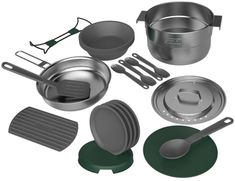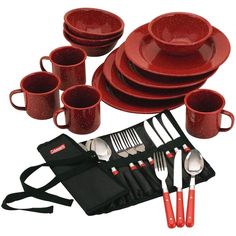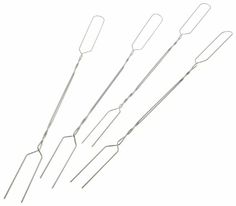Welcome to Tasteofthekitchen to Camp Cooking Guide! This guide aims to provide you
with the ultimate resource for cooking delicious meals while sitting around the campsite.
Whether you’re new to camping, or a seasoned veteran camper, this guide aims to provide you with the ultimate campfire cooking resource. We want to help you take your camping experience beyond the tent, helping you master the great outdoors. Whether you’re stopping for a meal while hiking or horseback riding, or you’re just camping in your backyard, this guide has something for you.
Let’s talk about what this guide aims to cover. We want to start by giving you an overview of the camping gear you’ll need for cooking. We will discuss some of the most popular devices for outdoor cooking, talking about their proper usage and maintenance, as well as how to exercise the right safety measures.
We will talk about fire grates, skewers and roasters, camping stoves, and outdoor grills, some of the most popular tools for cooking. We will also cover cooking accessories from coolers to cookware and utensils.
After going over the gear, we will look at some of the most important cooking methods you should know for preparing your outdoor cuisine. We’ll tell you how to make your meals over everything from an open fire to a grill, and teach you about some of the more nuanced methods like using a Dutch Oven. We’ll also talk about cooking on the go and how to prepare snacks for the road.
Finally, we have included some of our favorite campsite recipes. At the end of the book, you’ll find some great breakfast, lunch, and dinner recipes, as well as tasty snacks and desserts, all designed and tailored to your campsite needs.
Cooking Gear
For the ideal camping experience, you’ll need the right camping gear. Our first chapter looks at some of the different gear you can use for cooking while camping. We will talk about grates, stoves, and grills, as well as the various utensils and cookware you’ll need to make a meal while out in the woods.
Fire Grates
As kids, the best thing about camping was building the campfire. Even today, we adults still love collecting firewood, arranging the firewood neatly into a structure, setting up the tinder and kindling, and building a beautiful blaze out of a small spark. If you love campfires like we do, you should try cooking over a fire.
One great way to cook using a campfire is a fire grate. A fire grate is a large steel structure, similar to the grates you find on an outdoor grill. These grates are designed to fit over your campfire, letting you cook your food over the campfire without the risk of burning your meal.
Most campfire grates are square, but some are round. They usually have foldable legs.
My favorite grate is the Texsport Over-Fire Camp Grill. It’s made of steel, folds nice and works over just about any fire.
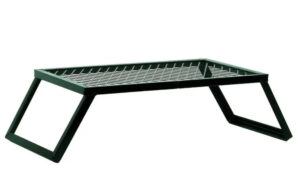
Some other models even include a fire pit underneath the grate, like this one from REI. While this makes it a bit bulky and difficult to carry to your campsite, such grates work well for your backyard. After all, you don’t want to dig a hole in your nice backyard grass!
Building a Fire Pit for a Grate
Clear a large area for the fire and surround it with rocks. Make sure the circle fits the size of your metal grate. You want to have the legs of the grate on the outside of the fire pit. Use rocks to make a circle, setting the limits of your fire.
Make sure the fire pit is deep enough so that the flames won’t reach.
When using this method, you need to make sure you time your meal with the gradual decline of your fire. Your fire needs to have significantly simmered down.
This makes the method problematic if you need to add fuel onto the fire. If you anticipate the fire dying down before you’re done cooking, build your fire in the shape of a figure-eight. Keep the fire going on one side, while using the other side for your cooking needs. When the fire under your grate starts to simmer, you can transfer embers from outside the grate underneath. This adds to the heat without burning your food up.
If you’d like to combine your fire pit and your grate in one, then check out this Heavy Duty Fire Pit with Cooking Grate from Catalina Creations. It combines the fire pit and grate in one which is perfect for your backyard fire’s and cooking
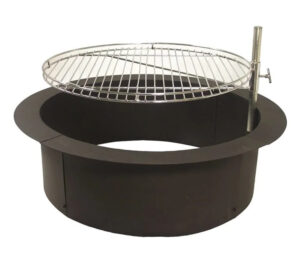
Camping Stoves
Looking to cook your eggs in the morning? If you like your eggs done carefully, you might prefer a gas stove to a campfire. In that case, we would recommend using a camping stove. Camping stoves are miniaturized versions of the gas stoves you might have in your home. They let you control the heat exactly, making them useful for cooking items at precise temperatures.
If you are camping in a place where fires aren’t allowed, we would recommend getting a camping stove.
Gas or a Wood Burning Stoves?
Both gas and wood burning stoves have their pros and cons and personally, I use both quite often. If I plan on using a base camp and have time to gather sticks, I will often choose a wood burning stove. If I am hiking, or consistently on the move, packing an ultralight gas stove tends to be my choice.
If you are looking for a great wood burning stove, I LOVE the Solo Stove (literally for any kind of camping). It’s lightweight, burns hot and packs up nicely.
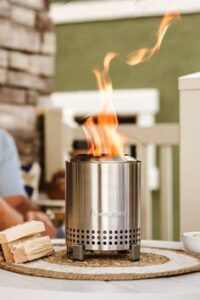
How to use a gas camping stove:
1. Preparing the fuel cylinder: First, make sure that the burners are turned off. Next, check the fuel cylinder regulator knobs: These should also be turned off. Now you can safely attach the fuel cylinder. Underneath the stove, you should find a regulator valve attachment. Attach the cylinder here, keeping it facing up. Once attached, tighten the regulator knob until the cylinder is secure.
2. Check for gas leaks: It’s important to make sure that there’s no gas leaks. One way to check this is to get a mixture made of a one parts dishwashing liquid and three parts water and apply it to the fixtures. Turn the regulator value two clicks into the on position, letting through no more than nine seconds of gas. If bubbles form, you’ve got a leak and need to tighten the bolts.
3. Light the stove: Slowly the regulator knob two clicks past the “off” position. Light the gas by holding a match over the burner. Be careful.
Now your stove is ready to cook!
What kind of camping stove should you use? Like I said earlier, it completely depends on the type of camping you will be doing. Family / car camping? Then a large 2-3 burner propane stove such as the Coleman Classic 2 Burner Camping Stove or the Solo Stove Titan (a bigger version of the original Solo Stove).
On the other hand, you probably want a lightweight model if you are going to be backpacking, hiking or canoeing. A great option is the Etekcity Ultralight Camping Stove. It’s cheap, light and portable.
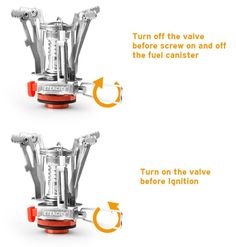
Camping Grills
Another popular way to cook your food while camping is using a grill. Sometimes, you can find a charcoal grill at the campsite. Another option would be a portable gas grilllike the Coleman Roadtrip. This portable propane grill has plenty of grilling space and packs tight for travel. It work well for cooking everything from vegetables, chicken, or burgers.

Guide to Public Grills
These grills are often located at parks or near public benches. When using a public grill, we would recommend cleaning the grill thoroughly before using it. The grill has been exposed to the elements, and you don’t know whether the last person to use it cleaned up afterward.
Start by cleaning out the grates. Take a grill brush and briskly scrub the surface of the grill. It doesn’t need to be perfect, as you will be doing this again once the grill gets hot. Try removing the grate, if possible. If you don’t have a grill brush, wad up a ball of aluminum foil as a substitute.
Clean out the bottom of the grill. Empty out the ash catcher.
Cover the grill with foil. This will prevent whatever you’re cooking from contacting the surface of the grill, keeping it clean and preventing it from dropping.
If not using foil, preheat the grill to burn off any old debris, then brush thoroughly.
Clean up the grill after you’re done! You should always leave your campsite in a better condition than you found it.
If you don’t like the idea of cooking on a public grill, a portable grill works just as well. These run off various types of fuel, such as propane. Check our instructions for a portable stove in the previous section for using these, as they operate in a similar manner. The main difference is that a portable grill uses the flame to heat the grilling surface, rather than the bottom of a pan.
Camping Cookware
Once you have picked a method, you’ll need some pots and pans for preparing meals. While one cooking pot can suffice in a pinch, if you have a larger group of campers or a variety of things being cooked, you might need more.

